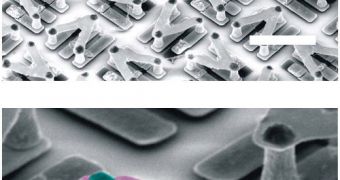A group of experts at the US Department of Energy's (DOE) Lawrence Berkeley National Laboratory (Berkeley Lab), in California, announces the development of an artificial molecule, whose chirality can be switched using just a beam of light.
Chirality can be defined as one of the most important properties of asymmetry. A molecule is considered to be chiral if it cannot be superposed onto its mirror image. Earth's life, for the most part, uses the left-handed version of amino-acids to create proteins.
In the new study, Berkeley Lab investigators led a multi-institutional team of scientists that worked out how to create a molecule which would change its chirality when exposed to a particular type of light.
In the short term, the results of this study may be used to improve energy efficiency for data processing applications, homeland security, ultrahigh-speed communications and terahertz technologies. Terahertz waves are located between infrared and microwave radiations on the electromagnetic spectrum.
Chirality can also be defined as orientation or handedness, and can be either left or right. A molecule's left- and right-handed versions are called enantiomers. These variants of the same molecule can display properties that are very different from each other.
“Natural materials can be induced to change their chirality but the process, which involves structural changes to the material, is weak and slow. With our artificial molecules, we’ve demonstrated strong dynamic chirality switching at light-speed,” Xiang Zhang explains.
The expert holds an appointment as a principal investigator at the Berkeley Lab Materials Sciences Division (MSD), and was one of the leaders on the new research.
“In contrast to previous demonstrations where chirality was merely switched on or off in metamaterials using photoelectric stimulation, we used an optical switch to actually reverse the chirality of our THz metamolecules,” Zhang goes on to say.
He also holds an appointment as the Ernest S. Kuh Endowed Chair professor of mechanical engineering at the University of California in Berkeley (UCB). Details of the new research were published in the latest issue of the top scientific journal Nature Communications.

 14 DAY TRIAL //
14 DAY TRIAL //